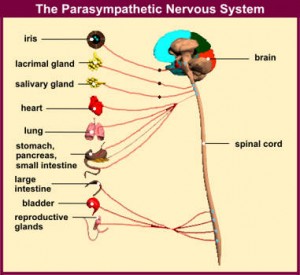 Aaaahhhhhh – is the sound of the parasympathetic nervous system.
Aaaahhhhhh – is the sound of the parasympathetic nervous system.
The parasympathetic nervous system is a division of the autonomic nervous system which is a division of the peripheral nervous system. The autonomic nervous system regulates actions beyond our control such as heart rate, respiration, perspiration and other similar functions.
The parasympathetic nervous system works with the sympathetic nervous system to maintain homeostasis in the body—these two divisions of the autonomic nervous system maintain the balance between excitation and relaxation. If you are afraid and the body feels that it is in danger the sympathetic nervous system will increase the heart rate putting the body on alert. If and when the danger passes the parasympathetic nervous system will slow the heart rate down. This is the dance of the autonomic nervous system doing it best to keep us in a state of equilibrium.
In ordinary circumstances this might be a basic proposition but we live in an extraordinary world of language and weaponry and the wide range of stimuli available to upset the apple cart of our mental emotional state are staggering. I believe that humans in the modern world have so many more trauma inducing opportunities than animals in the wild, and as a result are much more susceptible to disorders of the nervous system that is meant to keep us on an even keel. It ain’t easy being us.
Next we will cover flight or fight, or the sympathetic nervous system, and the role it plays as a complimentary opposite to the resting or inhibiting actions of the parasympathetic nervous system. The ability of these two divisions to work together equally can have an enormous influence on our emotional well-being. Tomorrow we will look at the sympathetic nervous system and its tendency to be the driving force of dysfunction within the body. We can get “stuck” in the sympathetic nervous system and when it goes on the fritz it can leading to problems relating to all sorts of pain, sensitivity, and depression.
The two systems originate from different places along the spine and their origin gives clues to both their function and relationship. The nerves of the parasympathetic division emanate from the cranium and the sacrum. And while I don’t know very much about craniosacral therapy other than all babies should get some, I do see a connection between the origins of the nerves of relaxation emanating from the same area where the craniosacral therapist works to balance the cerebrospinal fluid during a treatment.
As is my way I am happy to make leaps of thought that I don’t understand. If there are any craniosacral therapists or body workers with opinions or thoughts about this please weigh in.
***
